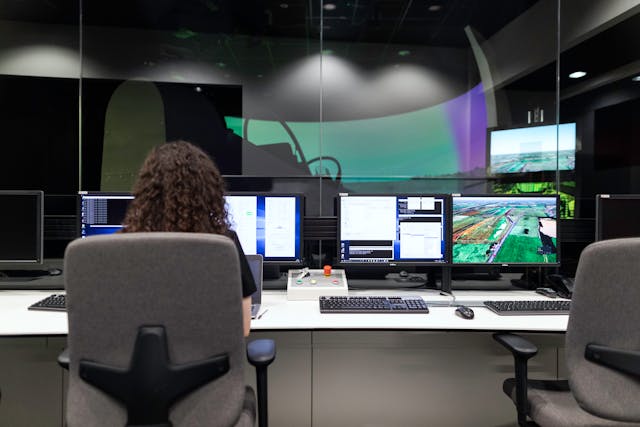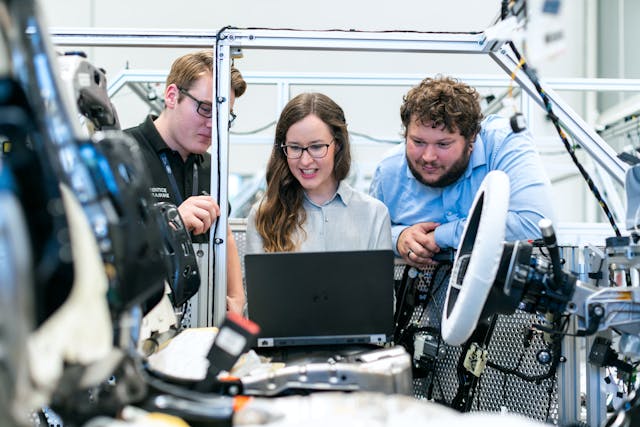There is a lot of interest around computer vision as a concept in industrial settings, to streamline production and find defects better. Enterprises can benefit from computer vision in multiple ways, which can leverage the existing vision ecosystem to make it smarter.
Machine vision is often used to make better sense of visuals that are captured by lenses, about certain objects and groups. They're used for inspections, quality checks, and passive analysis of generated data. Computer vision can make the ecosystem more active and real-time without requiring access to lenses or objects at the primary stage.
Machine vision for specific tasks and object analysis
Machine vision is ideal for specific tasks, such as line inspections, maintenance, and technical assistance, using data that is structured and an algorithm that is defined. It doesn't have the need to explore beyond its parameters to understand new information presented in the image.
It can also be ideal for settings that need processing for routine testing or similar appearing information. Line testing for defects, packaging, optical character recognition for labelling, and quality checking can be done through machine vision for pharmaceutical firms and manufacturers.
Machine vision also can't be used to extract valuable information from saved images and videos. It needs to be a part of a machine system that actively checks for specialized tasks and objectives. Industrial machine vision capabilities require specific objectives, such as tracking, sorting, and inspecting.
Computer vision for transformative learning and analysis
A key reason why industries are adopting computer vision is its ability to make more sense of the visual world through analysing multiple visual data points.
Firms can use data from cameras, security systems, motion capture, thermal, radar, and LiDAR, to actively analyse for transformational learning. The computer vision market alone is set to reach $386 billion by 2031 according to expert analyses, with retail, manufacturing, and automotive sectors being key industrial adopters.
A manufacturer can integrate computer vision to track discrepancies, check for quality issues, and improve worker productivity. Machine vision can't do that at the scale at which it is required by global industries. Artificial intelligence driven computer vision can improve processes and explore new solutions to existing challenges.
Computer vision can extract greater information from saved images and videos, and doesn't need to be a part of a larger machine vision system. It can drive greater value in industries such as autonomous vehicles, remote surgery, drone inspections, etc. These industries require active analyses, monitoring, and determining of multiple sets of real-time data.

Why leverage computer vision for industrial applications
Using computer vision for solving industrial problems will be the way ahead for several enterprises. Using edge computing, complex neural networks, and AI digital images processing, will be the ideal solution for more integrated analysis.
Computer vision systems can leverage machine learning, image processing, and deep learning models, to drive better outputs. Construction sites can perform real-time monitoring and inspection of upcoming projects, and healthcare facilities can improve post-op patient care by using vision to improve remission and relapse.
Remote management
Remote management can be seamlessly performed using computer vision in the industrial setting. Managers can track output, asset health, worker productivity, and overall functioning of the unit with ease through real-time computer vision technologies.
Real time inspections
Inspections of the production line using a computer vision system can be performed at-scale without machine vision technology being a limiting factor. Site inspection teams can check for faulty wiring, missing parts, equipment malfunctioning, and logistics delays, with real-time vision.
Research and development
Machine vision systems rely on specific objectives and tasks, based on which checks and detections can be performed. Computer vision can analyse image data and provide meaningful insights that can help improve innovation and development.
Quality control
Industries are improving their quality control systems by shifting operations from machine vision applications to computer vision based solutions. Testing of a wider range of products can be performed at-scale when computer vision is used to detect variables in design, flaws in manufacturing, and defects in production.
 /i
/i
These are some of the major areas wherein computer vision technology is adding significant value to industrial applications. Machine vision systems can work together with computer vision applications to help synchronize multiple functions into one cohesive system that can be well integrated.
Let's explore some of the major industrial trends that are driving computer vision work globally. This can also help us understand what application areas can be developed and innovated during adoption.
Industrial trends driving computer vision adoption
There are a range of trends that are enabling industries to adopt vision solutions into their infrastructure.
Increased need for greater visibility
A major trend that is driving the integration of computer vision in industrial settings is the need for greater visibility. Manufacturers, developers, and producers require greater access to visual data, especially related to information about their floor, fleet, workers, and assets.
Scope for improved processes
With edge computing and advanced neural networks, computer vision can improve how processes are executed across industries. Car manufacturers can improve their inspection times, and agricultural enterprises can detect crop disease cycles much quicker.
Better compliance
Computer vision is also allowing for better compliance to quality control and industry norms. Healthcare facilities can use computer vision to track diagnostics, and provide a more compliant way to treat patients long-term.
Environmental monitoring
Environmental monitoring, such as for security, urban planning, excavation, and inspections, can be vital for several industries. Computer vision helps in providing more real-time information about evolving site areas, to ensure that environments are suitable and secure for development.
Conclusion
Computer vision is enabling enterprises to track real-time visual information for transformational learning and analysis. While machine vision is focused on set specific tasks, computer vision can allow for a wider range of learnings based on product, equipment, site, and unit real-time visual information.
In the industrial setting, computer vision can help automotive sectors produce safer driverless vehicles. Healthcare sectors can empower doctors to perform surgery remotely, while tracking potential sites of infections or injury using computer vision. Retail adopters are using computer vision to understand consumer behaviours.
There are several applications for both machine vision and computer vision, but industries will find that computer vision can offer greater scope in solutions developing. Firms can integrate both technologies to maximize their results.